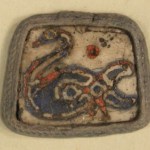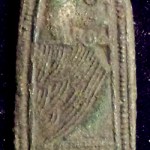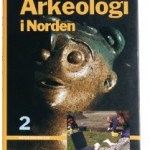This little guy is the new face of Old Uppsala. Most likely a religious amulet, being too small for a gaming piece, he showed up as a corroded lump in a cremation grave of the Late Vendel Period, early-8th century. The same grave also yielded a lovely millefiori glass bird gem, glass beads, and very unusually for its time, molten remains of silver objects. To my knowledge this is the richest female Vendel Period grave found to date at the old nucleus of Svealand, that is, the best candidate for the grave of an 8th century Queen of the Swedes.
Read more at the Old Uppsala project blog kept by…
vendel period
Guldgubbar are tiny pieces of gold foil with (usually) embossed motifs. They most commonly depict single men, then embracing couples, then single women, all in fine clothing. They date from the Vendel Period (540-790) and seem to have been religious artefacts. Usually they are found in the remains of elite residences, concentrating in and around roof-bearing postholes in the main hall. They form this gold-poor period's continuation of the Migration Period's gold bractate pendants and other sumptuous goldwork.
Gold foil figures weren't necessarily made where they are found. They are eminently…
23 years ago I started my undergraduate studies, and my hugely inspiring main teacher was Göran Burenhult, who had written our main textbook. Now I'm teaching a very similar freshman archaeology course for the first time, and the main textbook is again one written by Göran Burenhult. This two-volume work is titled Arkeologi i Norden and appeared in 1999. At Göran's invitation I contributed an article for the second volume about aristocratic culture in the 5th through the 8th centuries.
I haven't re-read my article in a long time. But very timely, my friend Kristina – who is writing a book…


